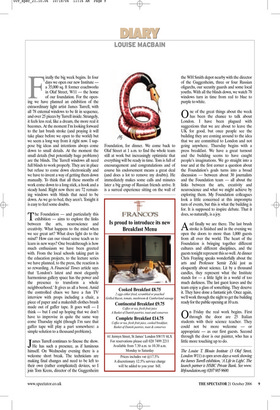F inally the big week begins. In four days we open
our new Institute a 35,000 sq. ft former coachworks in Olaf Street, W11 — the home of our foundation. For the opening we have planned an exhibition of the extraordinary light artist James Turrell, with all 78 external windows to be lit in sequence, and over 25 pieces by Turrell inside. Strangely, it feels less real, like a dream, the more real it becomes. At the moment I’m looking forward to the last brush stroke (and praying it will take place before we open to the world) but we seem a long way from it right now. I suppose big ideas and intentions always come down to small details. At the moment the small details (but potentially huge problems) are the blinds. The Turrell windows all need full blinds to work properly. They are in place but refuse to come down electronically and we have to invent a way of getting them down manually. To think that all these months of work come down to a long stick, a hook and a steady hand. Right now there are 72 remaining windows with blinds that need to be down. As we go to bed, they aren’t. Tonight it is easy to feel some doubts.
The Foundation — and particularly this exhibition — aims to explore the links between the arts, neuroscience and creativity. What happens to the mind when we see great art? What does light do to the mind? How can our visual sense teach us to learn in new ways? One breakthrough is how much enthusiasm we have been greeted with. From the local schools taking part in the education projects, to the lecture series we have planned, to the press, the reaction is so rewarding. A Financial Times article says that ‘London’s latest and most elegantly harmonious gallery space has the power and the presence to transform a whole neighbourhood.’ It gives us all a boost. Amid the controlled chaos we have a fun TV interview with props including a chair, a piece of paper and a makeshift clothes brush made out of gaffer tape. It goes well — I think — but I end up hoping that we don’t have to improvise in quite the same way come Thursday night (though I’m sure that gaffer tape will play a part somewhere: a simple solution to a thousand problems).
James Turrell continues to finesse the show. He has such a presence, as if luminous himself. On Wednesday evening there is a welcome short break. The technicians are making final changes and need to be left to their own (rather complicated) devices, so I join Tom Krens, director of the Guggenheim Foundation, for dinner. We come back to Olaf Street at 1 a.m. to find the whole team still at work but increasingly optimistic that everything will be ready in time. Tom is full of encouragement and congratulations and of course his endorsement means a great deal (and does a lot to remove my doubts). He immediately makes some calls and minutes later a big group of Russian friends arrive. It is a surreal experience sitting on the wall of the WH Smith depot nearby with the director of the Guggenheim, three or four Russian oligarchs, our security guards and some local youths. With all the blinds down, we watch 78 windows turn in time from red to blue to purple to white.
One of the great things about the week has been the chance to talk about London. I have been plagued with suggestions that we are about to leave the UK for good, but once people see the building they are coming around to the idea that we are committed to London and not going anywhere. Thursday begins with a press breakfast. We have a great turnout and the building seems to have caught people’s imaginations. We go straight into a tour and at the first corner a question about the Foundation’s goals turns into a broad discussion — between about 30 journalists and the Foundation team — all about the links between the arts, creativity and neuroscience and what we might achieve by exploring them. My Foundation colleagues look a little concerned at this impromptu turn of events, but this is what the building is for. It is supposed to inspire debate. That it does, so naturally, is a joy.
And finally we are there. The last brush stroke is finished and in the evening we open the doors to more than 1,000 guests from all over the world. The heart of the Foundation is bringing together different cultures and different disciplines, and the guests tonight represent this so well. At dinner Chris Frayling speaks wonderfully about the arts and Professor Semir Zeki just as eloquently about science. Lit by a thousand candles, they represent what the Institute stands for — a little light in a world of too much darkness. The last guest leaves and the team enjoy a glass of something. They deserve it. They have done a fantastic job. Once again, we’ll work through the night to get the building ready for the public opening at 10 a.m.
On Friday the real work begins. First through the door are 25 Italian students with their science teacher. They could not be more welcome — or appropriate — as our first guests. Second through the door is our painter, who has a little more touching up to do.
The Louise T. Blouin Institute (3 Olaf Street, London W11) is open seven days a week showing the James Turrell exhibition, A‘ Life in Light’. The launch partner is HSBC Private Bank. See www. ltbfoundation.org; 0207 985 9600.


































































































 Previous page
Previous page